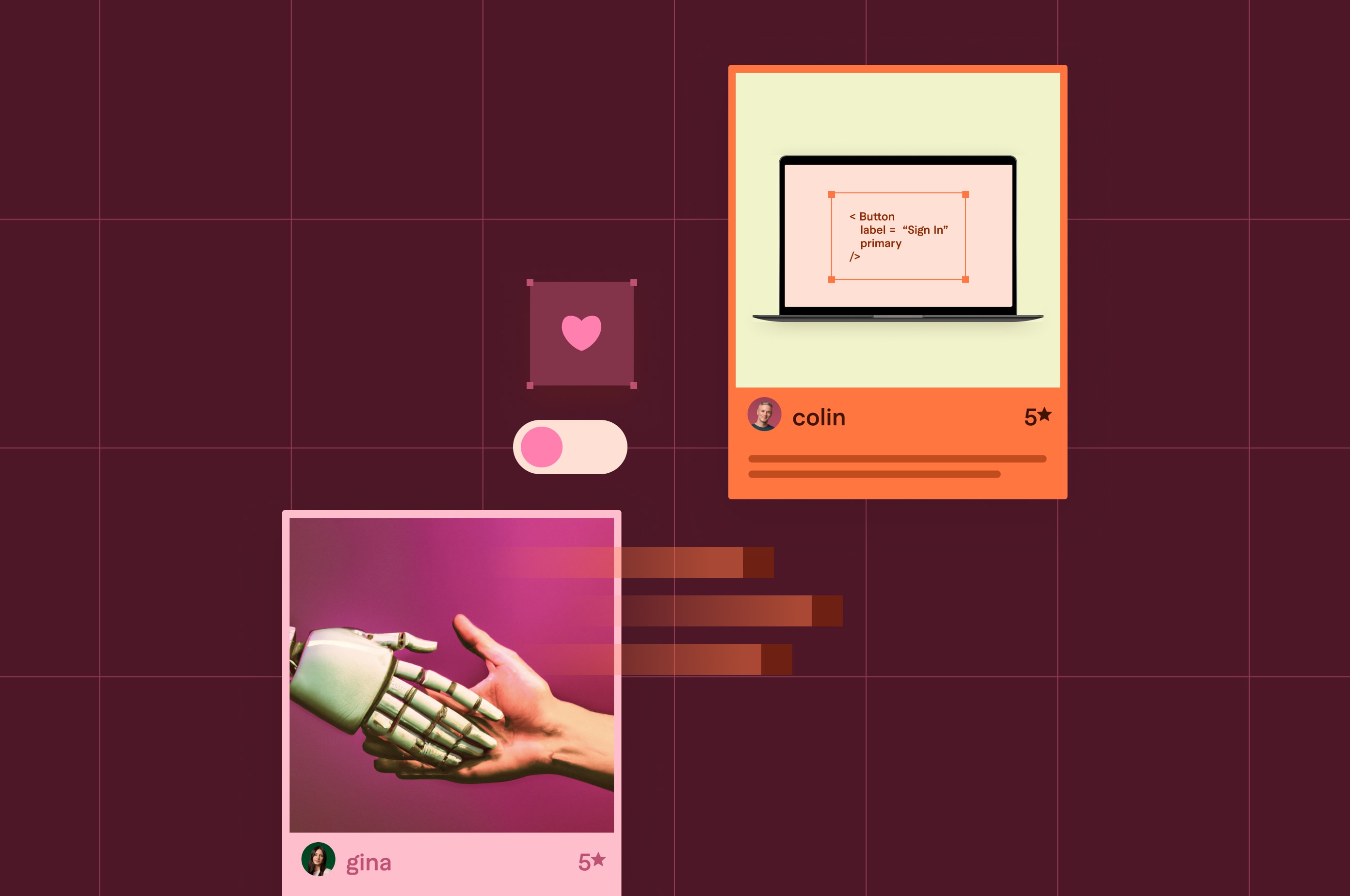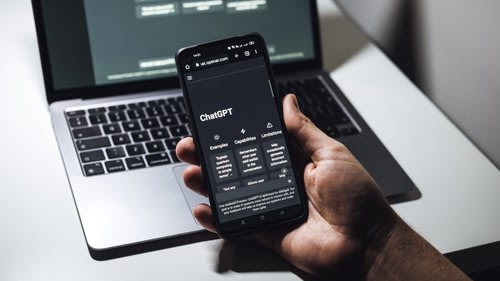How to build an artificial intelligence chatbot with ChatGPT to enhance customer service
Artificial intelligence chatbots can reinvent your customer service processes. Learn how to build a ChatGPT-powered AI chatbot to improve customer interactions and drive business growth.
 August 29, 2023
August 29, 2023 10 minute reading
10 minute reading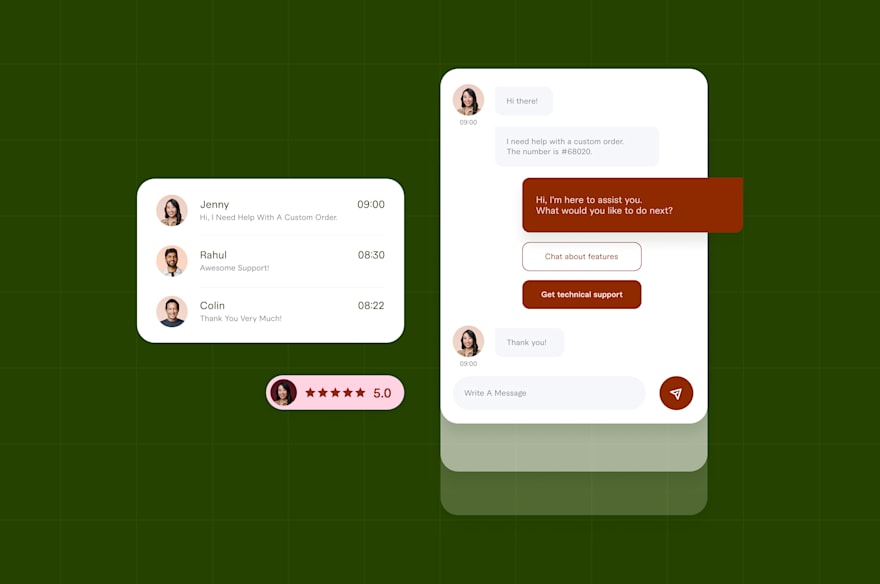
If you’ve used a chatbot to get help, chances are you’re familiar with responses like, “Sorry, I don’t understand,” “Do you want to try again?”, or “Can you rephrase your question?”
This frustrates customers, making your chatbot seem immature and unable to help customers accomplish their goals.
A survey by Gartner shows that despite a growing focus on and investments in chatbots, only 8% of customers used one during their most recent customer service experience. Of those, only 25% said they would use the chatbot again.
So how can you boost your chatbot’s ability to enhance the customer experience in your business? By building an artificial intelligence chatbot with generative AI tools like OpenAI’s ChatGPT.
Let’s review the benefits of using AI-powered chatbots and how you can build one to improve customer interactions to drive business growth.
What is an artificial intelligence chatbot and how does it work?
An artificial intelligence (AI) chatbot—sometimes referred to as a virtual agent—is a computer program that uses AI, deep learning, machine learning (ML), and natural language processing (NLP) to deliver automated responses, simulating human-like conversations.
Through conversational AI, ML, and NLP models, these virtual assistants understand a customer’s question, find or search for the best answer, and complete their intended action.
For example, Woebot Health uses Woebot—an AI-powered mental health tool trained in cognitive-behavioral therapy (CBT)—to meet the need for mental health care.
The chatbot integrates with health systems to provide evidence-based behavioral health solutions that reduce waitlists and set people on a path to feeling better.
Woebot tracks a user's mood to find patterns the average user may find difficult to analyze. And it talks to users about their wellness and mental health based on the user’s life and how they feel that day, then sends useful resources depending on the user’s specific needs and mood.
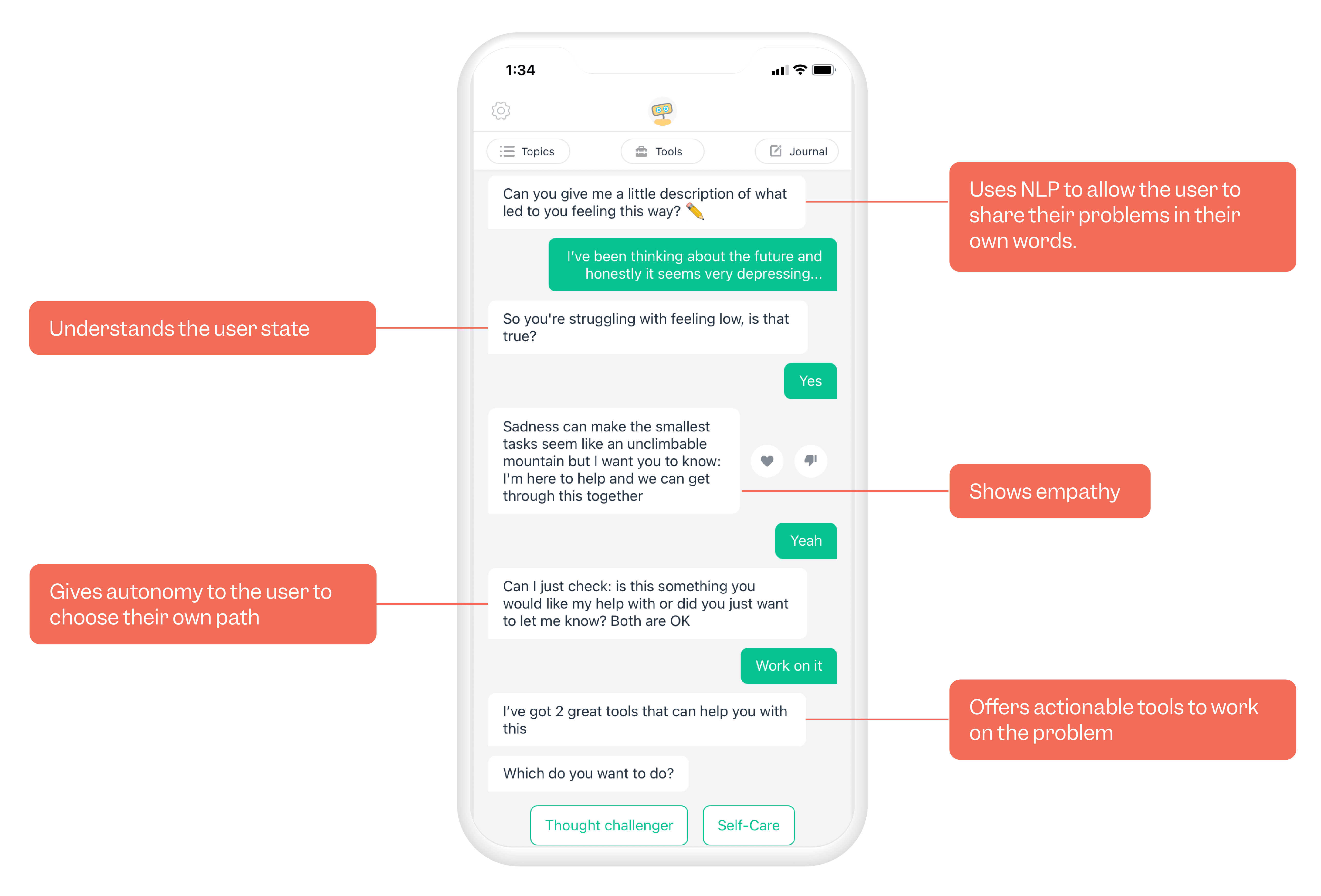
Source: Woebot Health
A key component of an AI chatbot is the large language model (LLM) it’s trained on. This model is based on an enormous dataset with millions of business-related words, phrases, and terms, which help the chatbot:
Understand customers’ requests in context
Extract information accurately
Deliver granular insights from business documents
Submit more accurate responses in real-time
Transfer customers to human agents when needed
Recognize plain-language responses from customers
Avoid asking redundant questions
Handle normal conversations, vague requests, misspellings, topic changes, and more without breaking
Unlike chatbots that rely on algorithm-based knowledge, AI chatbots deliver stronger and more accurate responses as it interacts with humans. That’s because AI chatbots use deep learning to understand the intention of a query and continuously build a web of appropriate, accurate, and more detailed human-like responses.
If you’re still on the fence about their capabilities, let’s look at the primary benefits they bring to your business.
Benefits of using artificial intelligence chatbots for customer support
AI chatbots can do wonders for your company’s customer service.
Besides processing data with human language, these bots create clear advantages for your business and customers.
Here are the main benefits of using AI chat.
1. Provide customer support 24/7
Unlike humans, AI chatbots don’t sleep. So you can guarantee someone’s always offering assistance outside normal business hours, such as:
Answering frequently asked questions (FAQs)
Making product recommendations
Helping with order tracking
This means quickly resolving your customers’ questions or concerns globally no matter their time zone, translating to increased customer satisfaction, lifetime value, and brand affinity.
2. Give automatic responses to customer queries
Responding to the same questions over and over can be time-consuming for your support team. You can program AI chatbots to use natural language understanding (NLU) to respond to customers’ FAQs—without getting tired.
Moreover, chatbots can also steer your site visitors or customers to the next stage in the buyer’s journey. They can give upfront answers and increase the chances of converting leads or customers making purchases.
Outsourcing mundane, repetitive tasks to chatbots saves you time and frees your team to handle more complex issues or personalized conversations.
See how Major Tom’s FAQ chatbot starts conversations and steers visitors to the next step or desired information:
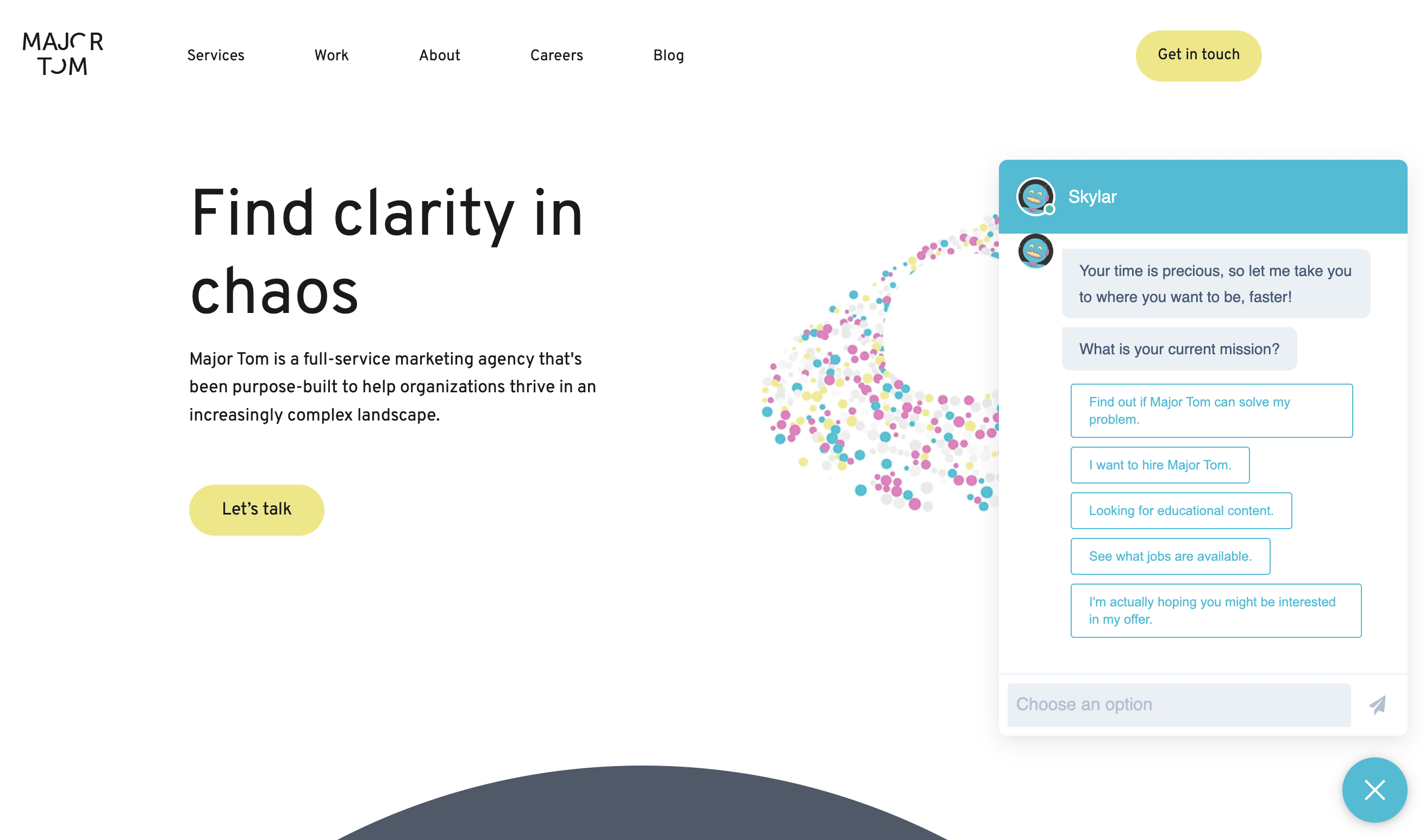
Source: Major Tom
3. Ease your customer service team’s workload
McKinsey’s 2022 State of Customer Care Survey shows 61% of customer care leaders say they’re receiving higher call volumes and more complex calls. Fifty-eight percent expect call volumes to increase further over the next 18 months.
The key drivers: a growing customer base and increased contacts per customer. These put greater pressure on already strained contact centers, further affecting capacity and leading to a more negative user experience overall.
What’s worse is the increased talent attrition brought by burnout, dissatisfaction, poor work-life balance, and no advancement opportunities. All these factors affect customer care capacity because employees are difficult to replace.
AI chatbots reduce call or chat volumes, freeing your team to focus on conversations that drive more impact.
4. Increase direct sales opportunities
With the boom in social commerce, ecommerce businesses can scale customer support to AI chatbots.
These bots can plug into your social media channels and offer automated support on your website. This brings several benefits, including:
Offering an omnichannel experience
Scaling customer support across platforms
Engaging your audience where they are
Driving sales
Ssense—a Canadian fashion e-tailer—uses a generative AI chatbot to help visitors with their shopping and styling questions. The bot integrates directly into ChatGPT using a mix of OpenAI’s GPT technology and proprietary AI technology models, allowing shoppers to ask questions and get responses with links to products from the retailer’s catalog.

Source: Business of Fashion
For example, if a shopper needs recommendations for warm, luxury outfits in bold colors, the AI chatbot will suggest relevant items and other mix-and-match products.
Ssense experimented with the ChatGPT-powered bot on its Instagram account to explore how generative AI bots can improve the online shopping experience.
The company hopes the bot’s language abilities can offer shoppers more guidance in their search through a conversational experience that provides human-like support.
5. Deploy your brand voice across touchpoints
Omnichannel experiences are vital for businesses because today’s consumers want to shop online and then buy in-store—or vice versa.
With AI chatbots, you can set and expand your brand voice and personal style online across multiple touchpoints, giving shoppers a seamless, consistent brand experience and support.
6. Speak to customers in their own language
Besides providing 24/7 support, AI chatbots let you serve your customers in their own language through multilingual support. You can expand your business globally while ensuring your customers get the same support no matter their language.
7. Reduce support team costs
AI chatbots provide support services and are scalable at a fraction of the cost of customer care teams.
For instance, if you hire support employees, you’ll have to pay a full-time salary plus employee benefits. If you hired the same team to work around the clock, the costs would rack up.
You can get the best AI chatbots for free or pay a monthly subscription fee, which is cheaper compared to hiring more workers. For instance, Bing chat is available for free via Microsoft Edge, though in the future, the company intends to charge it as a standalone offer for $5 per user, per month. Other free ChatGPT alternatives, like:
8. Access valuable customer data
AI chatbots can provide valuable insights about your customers, such as their preferences, behaviors, and needs.
The bots analyze chat logs, giving you a better understanding of your customers' pain points so you can review and identify opportunities for improvement. With this data, you can also optimize your products and services to meet your customers’ needs, provide personalized experiences, and boost brand loyalty.
9. Reduce cart abandonment
Cart abandonment happens when an online shopper adds items to their cart, but leaves before making a purchase due to:
Complex checkout processes
Unexpected shipping costs
Lack of trust
AI chatbots can answer customers’ questions, giving them the confidence to purchase or upgrade their accounts. Even if the shopper isn’t ready to connect, the chatbot’s quick and convenient responses can build customer trust in your brand.
Abandoned cart chatbots with access to a shopper’s context can also offer discounts, incentivizing customers to purchase. The bot can know when the shopper has an item in their cart and offer the discount at the right time.
AI takes abandoned cart workflows further by providing intelligent, personalized recommendations, which help increase the total cart value.
10. Boost your company’s internal support strategy
You can use AI chatbots in your business to support employees and empower them to self-serve. Chatbots direct employees to a knowledge base or help center, thereby scaling your internal self-service efforts. This is particularly helpful when making company-wide changes or during employee onboarding.
Other teams can also use bots to answer FAQs over email, Slack, WhatsApp, Facebook Messenger, and other convenient internal messaging channels. This way, employees get fast help around the clock, regardless of their time zones.
With these benefits, use cases, and examples in mind, let’s look at how you can build your own AI chatbot with ChatGPT to enhance customer service in your organization.
How to build an AI chatbot with ChatGPT
Chatbot technology has evolved from the basic bots to conversational agents, to generative AI like ChatGPT, advanced NLP, and more.
For this guide, we used Botsonic—a no-code AI chatbot builder—to build our ChatGPT-powered bot quickly without writing ChatGPT code. The tool uses GPT-4—the most advanced GPT technology—to custom-train your AI chatbot, making it faster and more efficient.
Botsonic uses an embedded script or API key, for seamless integration with your app or website. You also get flexible branding and customization options, including your logo, bot icon, and colors.
Follow the steps below to get started:
1. Create an account on Writesonic or log in if you already have one.
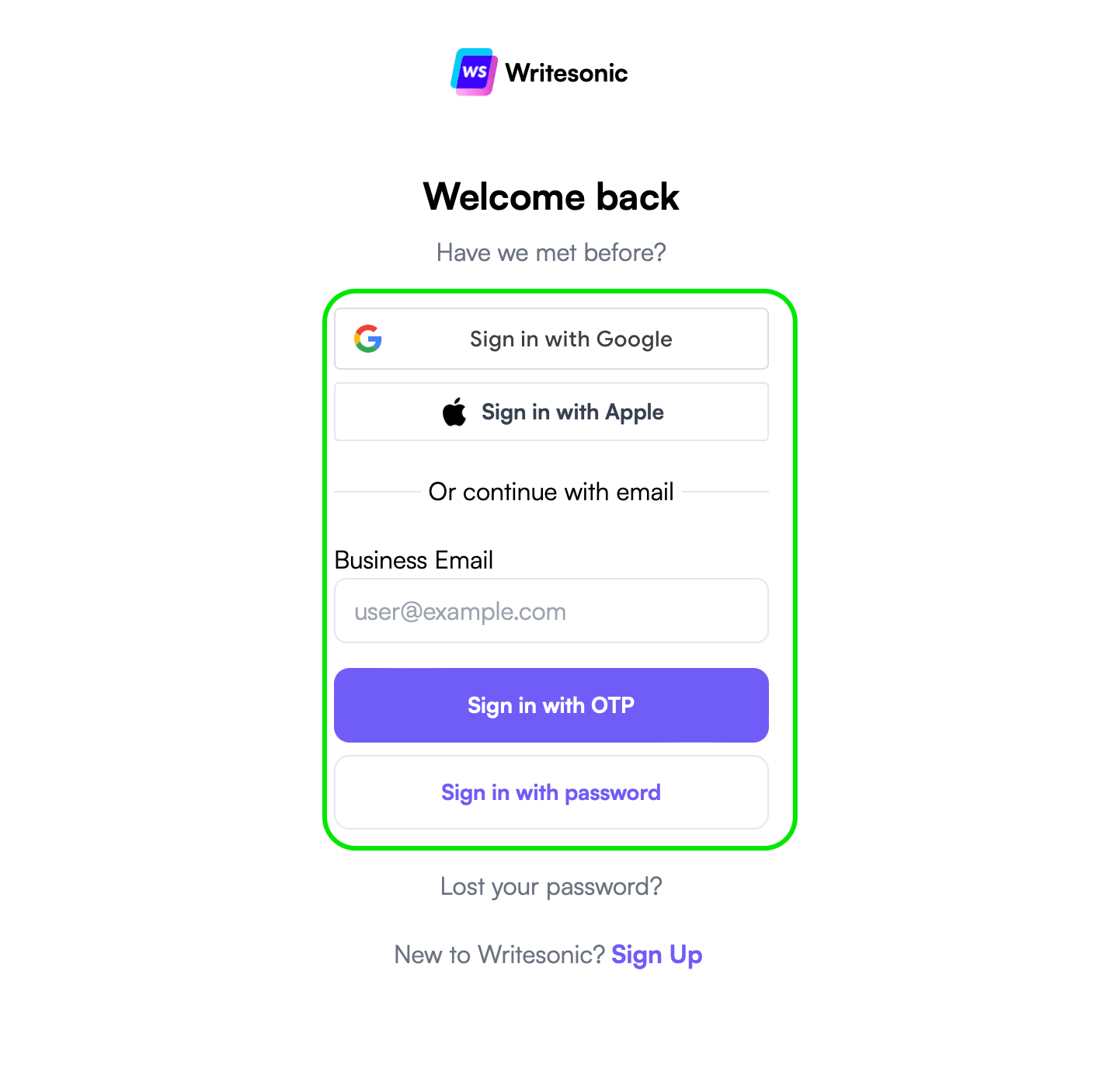
2. From the Library options, select the Botsonic card.
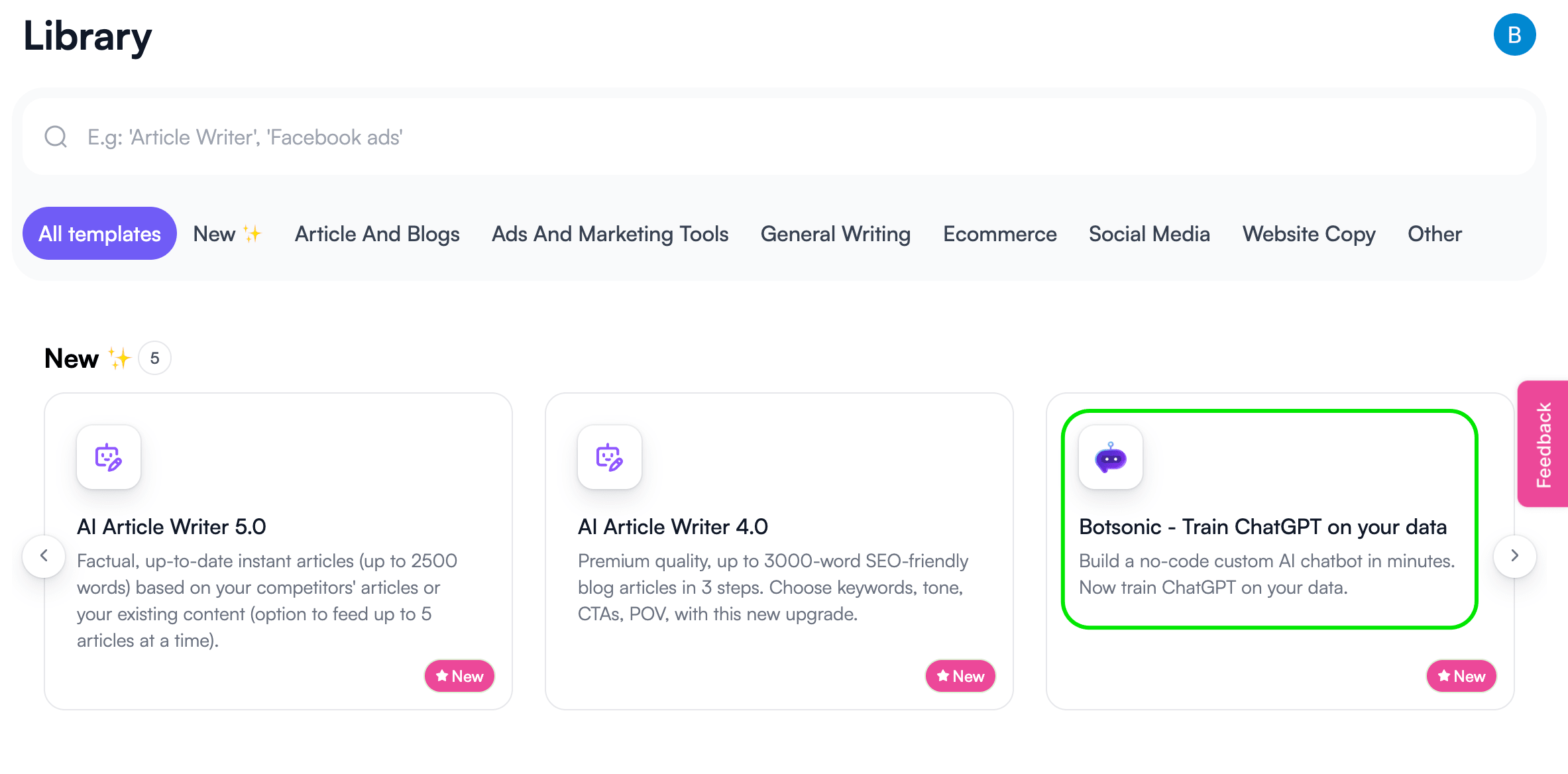
3. Next, select the Create New or Create a bot button.
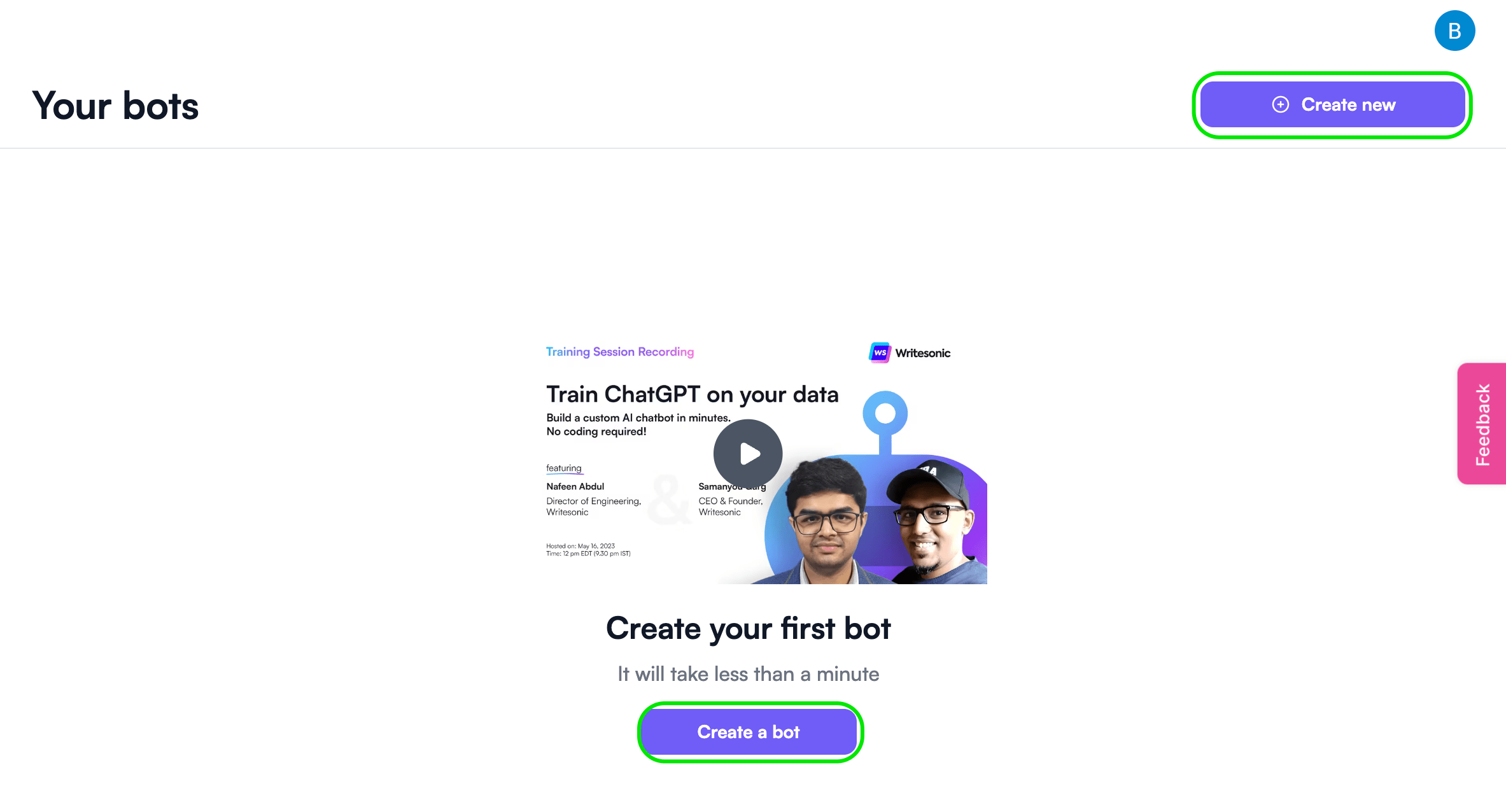
4. Enter the name you’ll give your bot then select Continue. For example, you can call it “Customer Service Bot.”

5. Upload the resource containing the data you’ll feed your ChatGPT-powered chatbot with. It can be a website link, document (PDF, DOC, DOCX, PPT, or PPTX), sitemap, or FAQs—or all of them.

6. Select Upload and Train. Once uploaded, the file name will appear under the Files/URLs section.
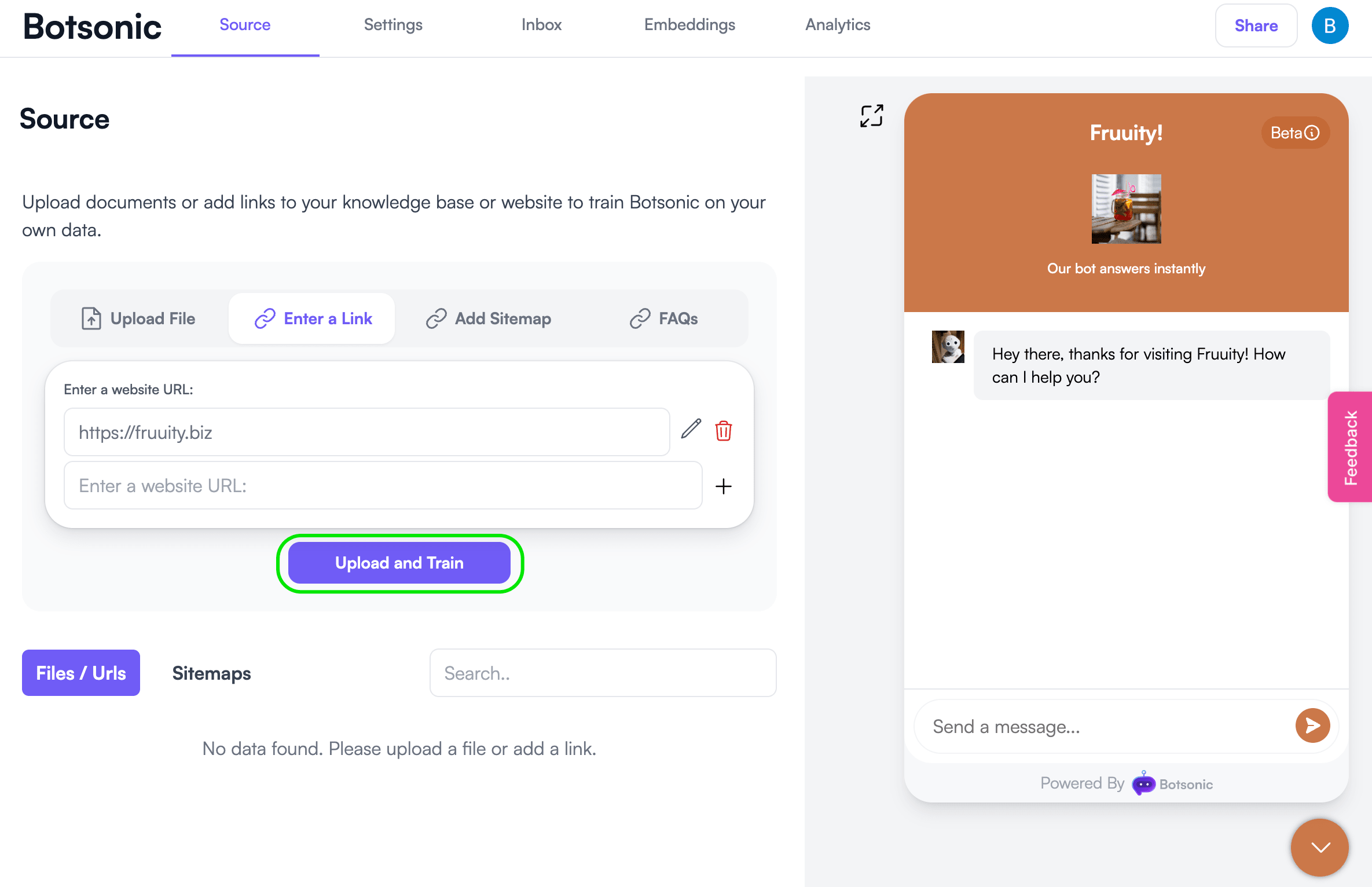
7. If you use a website link, wait for the data to be scraped from your website. You can add more links based on the data you want to train the chatbot on. Once complete, the Trained update will appear under the Files/URLs section.
You can also add your Sitemap data in CSV format and FAQ data, so the chatbot can submit relevant answers to your customers’ queries. Once you add these files, select Upload and Train again and wait for the process to complete.
After successfully training your AI chatbot, the next step is to customize the bot with your brand identity.
8. Select Settings to open the customization options, which include appearance, bot settings, starter questions, and user form. You can customize what your widget will look like, changing the logo, bot avatar, and button icon colors. Any changes you make will appear in the preview on the right pane.
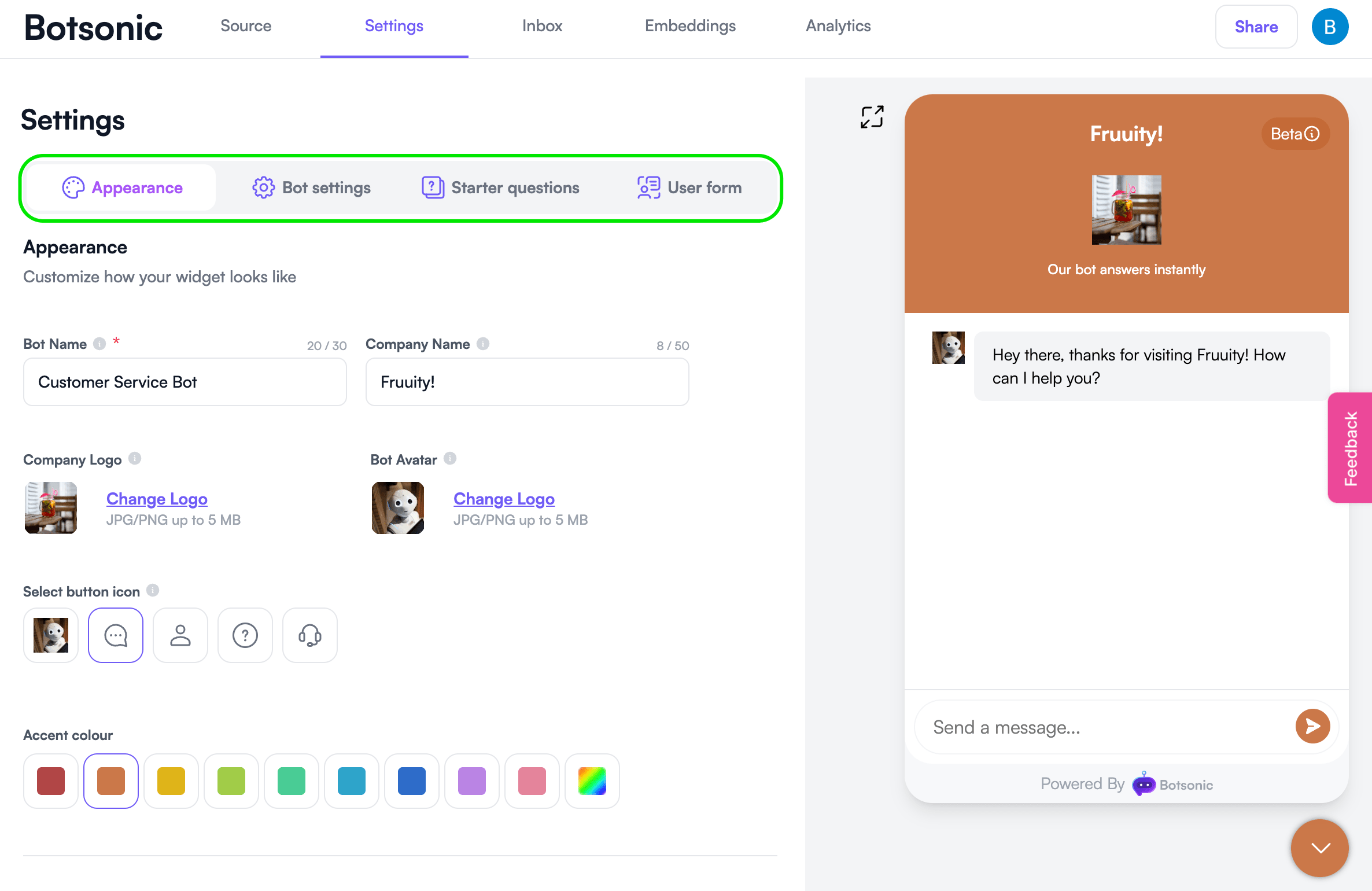
You’ve successfully trained ChatGPT bot with your knowledge base.
9. Botsonic will generate an embeddable code, which you can use to embed the chatbot on your website. An API key is available but only for Writesonic’s premium plan subscribers.

10. Set up starter questions as conversational prompts to test your bot.
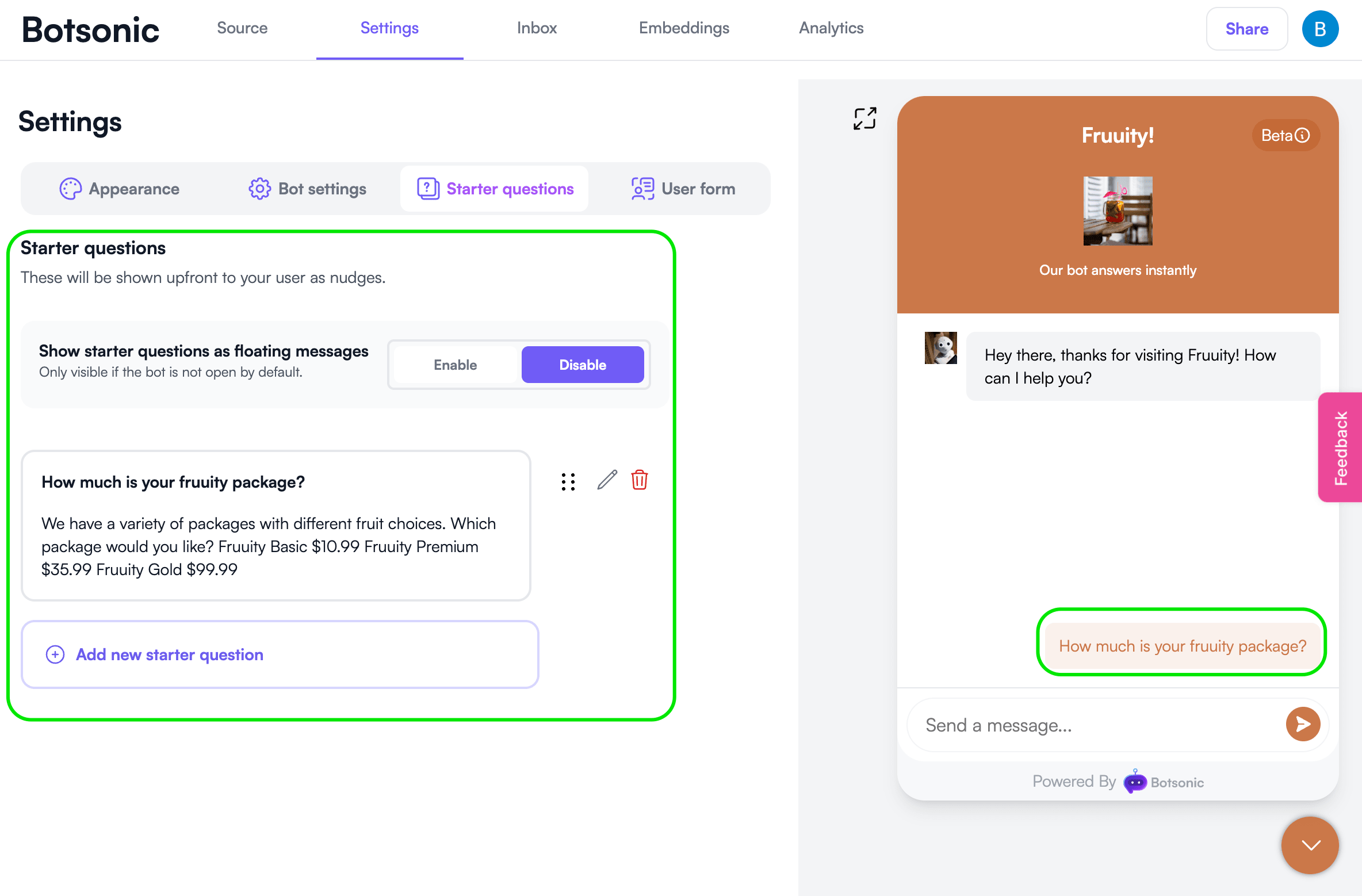
You can also set up the data you want to collect by configuring the customer data and preferences. And you can go view all your bot’s customer conversations in the Inbox section. The Analytics tab shows information about your bot’s chats with customers, such as number of chats, messages, and words.
That’s it! You have an AI chatbot for your business powered by ChatGPT.
Botsonic is available in all of Writesonic’s pricing plans, but you can only build one bot with the free plan. If you need more bots, you can upgrade to premium plans. There are other providers you can use, such as Chatfuel and Tidio, which can streamline routine tasks, improve user engagement, and enhance customer support.
If you’d rather someone build your bot, buy the services of an AI prompt engineer to build it and then get an AI prompt writer to talk to GPT-3 by creating professional text-based AI prompt ideas.
What to look for in an AI chatbot
Creating an AI chatbot for your support team’s needs depends on several factors. Consider the resource gaps you’re dealing with and pick a chatbot with the relevant functionalities to fill those gaps.
Here are some questions to ask that can guide your decision:
What are your current support needs?
What problem or pain points are you looking to solve in your organization?
What resources do you have available to solve these issues?
How many support requests do you receive daily?
Of the requests, how many are recurring questions?
Have you identified any repetitive tasks in the customer support process?
Have you experienced support employee inefficiencies and downtime?
Does your customer relationship management (CRM) solution offer user-friendly, built-in, third-party, or custom-coded customization capabilities?
How long are the wait times for agents? If they’re too long, what are the reasons for long wait times?
Is your current chatbot flexible enough to work across multiple channels (websites, mobile apps, SMS, or social media)?
What level of context will your chatbot need to handle high volume support requests and provide solutions?
Do you have resources that your AI chatbot can use to learn or recommend to customers?
How will you manage chatbot-agent conversations?
Use your responses to identify which AI chatbots can meet your needs. For example, if you find many recurring questions among your customers’ requests, you can find a chatbot that can be trained on FAQs if you have a knowledge base.
Leverage AI for customer service automation
Ready to achieve new levels of automation in your customer service function? Build your own AI chatbot powered by ChatGPT and enhance the customer experience.
Find an AI expert on Fiverr
If you need extra hands to create useful AI chatbots, Fiverr offers a wide range of AI services and hosts freelancers with expertise in ChatGPT applications, AI chatbots, and other AI applications.
Plus, you can manage all your freelancers, projects, and payments on the platform at no additional cost.
Sign up to Fiverr to find AI chatbot experts who can build your AI chatbot with ChatGPT.
